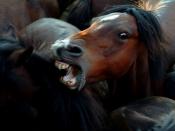Challenging behavior is any repeated pattern of behavior in young children that interferes with learning or engagement in social interactions (Porter, 2003). In other words socially inappropriate behavior can be considered as challenging behavior, because it is harmful to the child and others. In this essay I discuss aggression, biting and clinging to staff, which are challenging behaviors that are common among children. I also look into some possible causes for each of these behaviors and explain helpful guidance strategies that might be used in the early childhood centre to support the child and minimize the occurrence of these behaviors.
According to Kaiser and Raminsky (2003) any child can exhibit challenging behavior during his or her life. The most common challenging behaviors among children are hitting, biting, clinging onto adults, aggression, non- cooperation, non-attention, non-participation and many more .
The factors behind challenging behavior in children could be physical, biological, environmental, social and emotional.
Physical and biological factors include complications related to pregnancy due to drugs and alcohol, genetic make up, premature birth, gender difference, malnutrition, stress and fatigue (Kaiser & Rasminsky, 2003).
Environmental factors behind challenging behavior include socio economic conditions, too much violence and culture and family background (Kaiser & Rasminsky, 2003).
Social and emotional factors that influence behavior in children include developing a sense of trust or mistrust or building an attachment towards the caregivers (Katz & McClellan, 1997).
One or more of the above factors will influence a child's behavior. Therefore, it is very important as early childhood teachers to identify the root cause of the challenging behavior in order to minimize their occurrence.
Aggression can be defined as hostile or violent behavior or attitudes. "Aggression is being inconsiderate of the feelings of other children" (Porter, 2003, p.132). Very often verbal or non verbal aggressive behavior...


